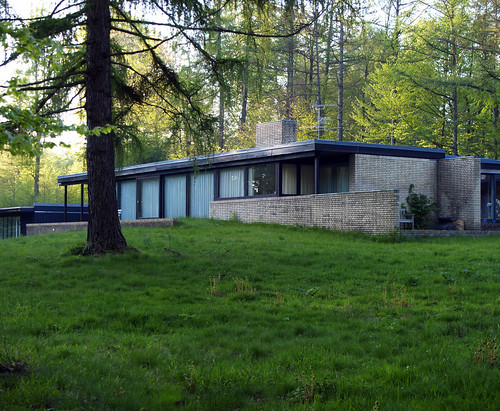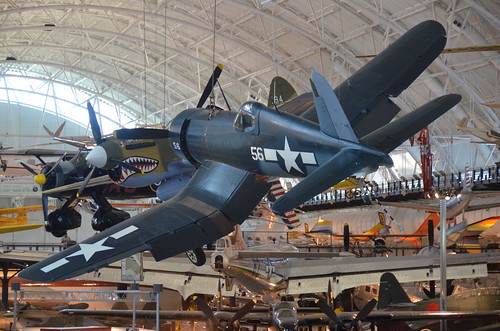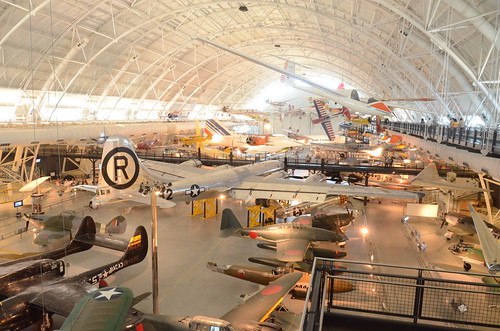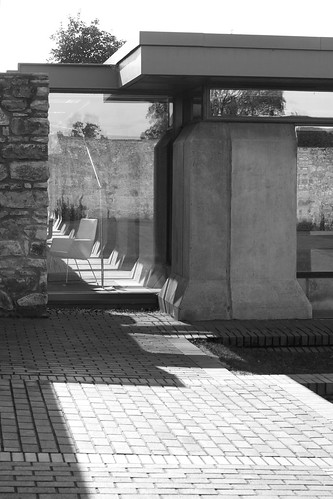jørn utzon, architect's own house, hellebæk, 1950-1952
Image by seier+seier
architect's own house, hellebæk, 1950-1952.
architect: jørn utzon.
here she is, a small house, yet expansive; monumental in conception, humble in materials; built in the middle of a forest, but raised on a low platform as if standing back slightly from nature, viewing it rather than being part of it.
from the lecture notes of kay fisker, utzon's teacher at the royal academy, we know that he would quote voysey's 1906 book, "reason as the basis of art":
"the sense of order conveyed by breath of surfaces and reposeful arrangement does suggest qualities akin to faithfulness, simplicity and selfcontrol. we do not naturally value simplicity in ourselves. to have travelled much, to be versatile and cosmopolitan in our tastes and complex in our behavior, is to most people more attractive than simplicity of character and conduct which, to aquire in these days, needs strong will and independent thought."
I am reminded of utzon's house by these words - it could never have happened without the English freestyle in the first place. yet contrary to voysey's rant, utzon appears to have learnt simplicity from his travels. today, such a claim is as absurd as voysey made it sound in 1906 but following the horrors of the second world war and the european selfdestruction, the idea of travelling the world to find a natural way to live and a natural way to build must have made a lot of sense.
utzon himself wrote, "the simple, primitive life in the country, trips into the mountains with skis or guns, sailing trips, a few weeks together with Arabs in the mountains and the desert, a visit to north america and mexico, the lifestyle of the Indians - all this has formed the basis for the way of life my wife and I have wanted to lead, and thus for the design of the house".
the house was listed in 2005. www.kulturarv.dk/fbb/sagvis.htm?sag=26904023
this photo was uploaded with a CC license and may be used free of charge and in any way you see fit.
if possible, please name photographer "SEIER+SEIER".
if not, don't.
more utzon here and here
Steven F. Udvar-Hazy Center: Vought F4U-1D Corsair, with P-40 Warhawk in background
Image by Chris Devers
Quoting Smithsonian National Air and Space Museum | Vought F4U-1D Corsair :
By V-J Day, September 2, 1945, Corsair pilots had amassed an 11:1 kill ratio against enemy aircraft. The aircraft's distinctive inverted gull-wing design allowed ground clearance for the huge, three-bladed Hamilton Standard Hydromatic propeller, which spanned more than 4 meters (13 feet). The Pratt and Whitney R-2800 radial engine and Hydromatic propeller was the largest and one of the most powerful engine-propeller combinations ever flown on a fighter aircraft.
Charles Lindbergh flew bombing missions in a Corsair with Marine Air Group 31 against Japanese strongholds in the Pacific in 1944. This airplane is painted in the colors and markings of the Corsair Sun Setter, a Marine close-support fighter assigned to the USS Essex in July 1944.
Transferred from the United States Navy.
Manufacturer:
Vought Aircraft Company
Date:
1940
Country of Origin:
United States of America
Dimensions:
Overall: 460 x 1020cm, 4037kg, 1250cm (15ft 1 1/8in. x 33ft 5 9/16in., 8900lb., 41ft 1/8in.)
Materials:
All metal with fabric-covered wings behind the main spar.
Physical Description:
R-2800 radial air-cooled engine with 1,850 horsepower, turned a three-blade Hamilton Standard Hydromatic propeller with solid aluminum blades spanning 13 feet 1 inch; wing bent gull-shaped on both sides of the fuselage.
• • • • •
Quoting Smithsonian National Air and Space Museum | Curtiss P-40E Warhawk (Kittyhawk IA):
Whether known as the Warhawk, Tomahawk, or Kittyhawk, the Curtiss P-40 proved to be a successful, versatile fighter during the first half of World War II. The shark-mouthed Tomahawks that Gen. Claire Chennault's "Flying Tigers" flew in China against the Japanese remain among the most popular airplanes of the war. P-40E pilot Lt. Boyd D. Wagner became the first American ace of World War II when he shot down six Japanese aircraft in the Philippines in mid-December 1941.
Curtiss-Wright built this airplane as Model 87-A3 and delivered it to Canada as a Kittyhawk I in 1941. It served until 1946 in No. 111 Squadron, Royal Canadian Air Force. U.S. Air Force personnel at Andrews Air Force Base restored it in 1975 to represent an aircraft of the 75th Fighter Squadron, 23rd Fighter Group, 14th Air Force.
Donated by the Exchange Club in Memory of Kellis Forbes.
Manufacturer:
Curtiss Aircraft Company
Date:
1939
Country of Origin:
United States of America
Dimensions:
Overall: 330 x 970cm, 2686kg, 1140cm (10ft 9 15/16in. x 31ft 9 7/8in., 5921.6lb., 37ft 4 13/16in.)
Materials:
All-metal, semi-monocoque
Physical Description:
Single engine, single seat, fighter aircraft.
Steven F. Udvar-Hazy Center: View of south hangar, including B-29 Superfortress "Enola Gay", a glimpse of the Air France Concorde, and many others
Image by Chris Devers
Quoting Smithsonian National Air and Space Museum | Boeing B-29 Superfortress "Enola Gay":
Boeing's B-29 Superfortress was the most sophisticated propeller-driven bomber of World War II and the first bomber to house its crew in pressurized compartments. Although designed to fight in the European theater, the B-29 found its niche on the other side of the globe. In the Pacific, B-29s delivered a variety of aerial weapons: conventional bombs, incendiary bombs, mines, and two nuclear weapons.
On August 6, 1945, this Martin-built B-29-45-MO dropped the first atomic weapon used in combat on Hiroshima, Japan. Three days later, Bockscar (on display at the U.S. Air Force Museum near Dayton, Ohio) dropped a second atomic bomb on Nagasaki, Japan. Enola Gay flew as the advance weather reconnaissance aircraft that day. A third B-29, The Great Artiste, flew as an observation aircraft on both missions.
Transferred from the United States Air Force.
Manufacturer:
Boeing Aircraft Co.
Martin Co., Omaha, Nebr.
Date:
1945
Country of Origin:
United States of America
Dimensions:
Overall: 900 x 3020cm, 32580kg, 4300cm (29ft 6 5/16in. x 99ft 1in., 71825.9lb., 141ft 15/16in.)
Materials:
Polished overall aluminum finish
Physical Description:
Four-engine heavy bomber with semi-monoqoque fuselage and high-aspect ratio wings. Polished aluminum finish overall, standard late-World War II Army Air Forces insignia on wings and aft fuselage and serial number on vertical fin; 509th Composite Group markings painted in black; "Enola Gay" in black, block letters on lower left nose.
Scotstoun House
Image by itmpa
The glazed link between the new extension and the 1965 building is the most successful part of the recent scheme - although by no means a unique idea, the use of the top-lit space as a meeting room is what makes it particularly appealing.
No comments:
Post a Comment